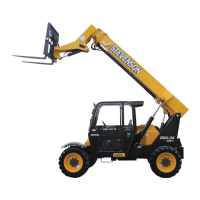PRINTED IN U.S.A. 37 913323/CP0112
LIFTING ATTACHMENT TOOL APPLI-
CATIONS
Picking Up the Load
Inspect the load before picking it up. If it appears
unstable, DO NOT attempt to move it. DO NOT
attempt lifting double-tiered loads, or straddling side-
by-side pallets with one on each fork. NEVER add
extra unauthorized counterweights to the machine.
Approach the load slowly and squarely with the
machine straight and level. Adjust the space between
forks, if necessary. Engage the load equally on the
forks until the load touches the carriage backrest. Tilt
the forks back to position the load for travel.
Carrying the Load
If the load obstructs your view, get someone to direct
you. Maintain ground speeds consistent with ground
conditions and that permit stopping in a safe manner.
Load Elevation and Placement
For ground level load placement, be sure the area
under the load and around the machine is clear of
equipment and personnel. Lower the load to the
ground, tilt the forks to the horizontal position, and
then carefully back away to disengage the forks from
the load.
Example: The operator, using a standard carriage
attachment tool, wants to raise a 2000 lb. load 20 feet
high, and can only get to within 15 feet of the load
placement point. Can it be done within the capacity of
the machine?
Analysis: See “Typical Load Zone Chart” below.
Projecting up from the 15-foot reach mark on the hor-
izontal axis to intersect a line through the 20-foot
height mark on the vertical axis shows that a load up to
2000 lb. can be placed in that zone.
During placement, the operator should observe when
the boom extension mark number “4” on the boom is
visible and stop further extension. The operator knows
the maximum safe extension distance with the 2000 lb.
load has been reached.
WARNING
Operating conditions such as slopes or soft
ground can reduce the machine’s safe operat-
ing capacity. Exceeding the capacity when
raising or extending the boom will cause the
machine to tip forward.
WARNING
NEVER exceed the rated operating capacity of
the Telescopic Handler as shown on the load
zone charts.
BOOM
EXTENSION
MARKERS
DISTANCE LOAD IS EXTENDED
Typical Load Zone Chart
HEIGHT ABOVE GROUND
WARNING
NEVER travel with the boom above the carry
position (attachment tool should be at mini-
mum ground clearance). Boom should be fully
retracted.
Use lower gear when traveling down an
incline. NEVER coast with the transmission in
neutral. Travel up and down grades slowly.
DO NOT operate the machine on a slope or
grade that exceeds 22% or 12
o
.

